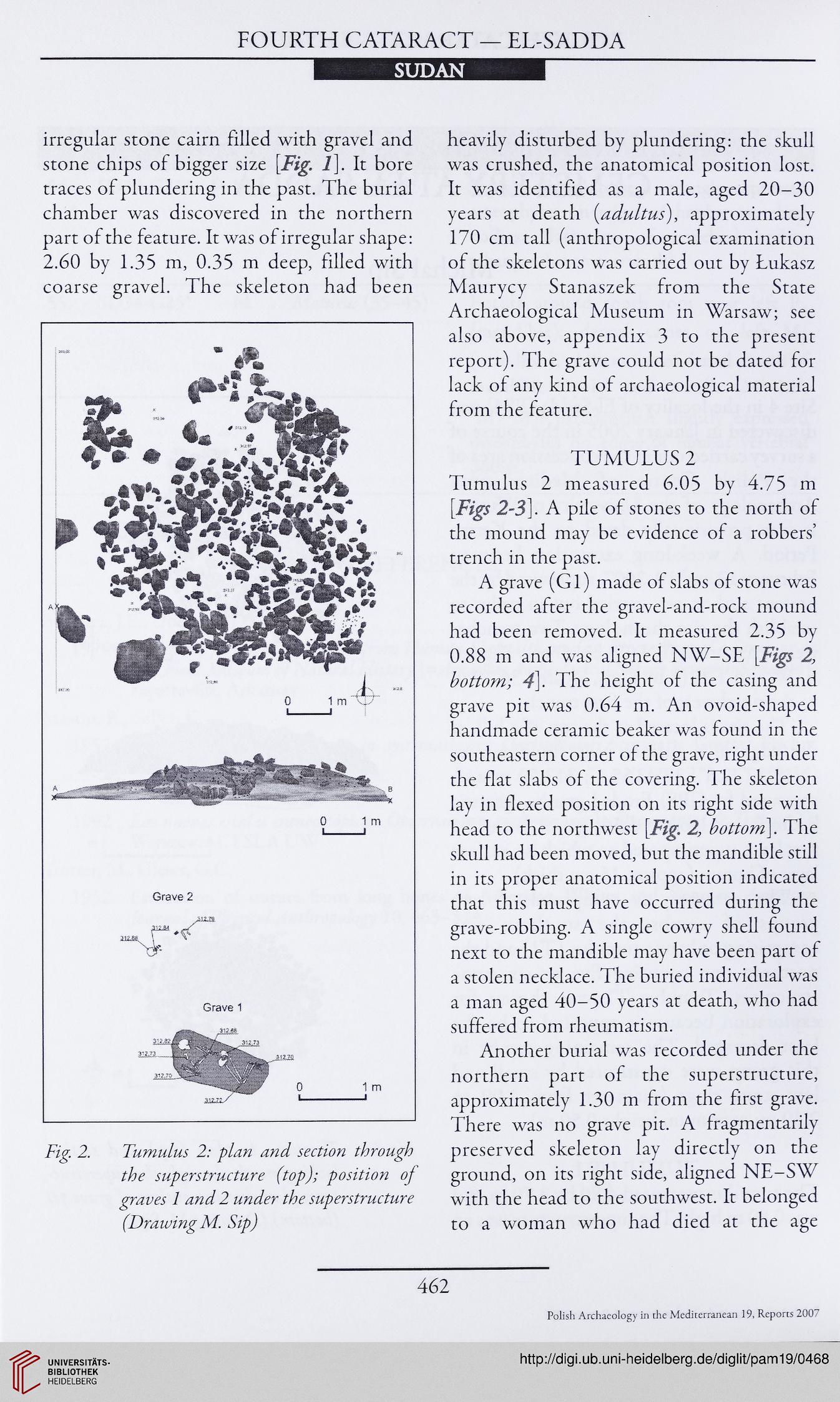FOURTH CATARACT — EL-SADDA
SUDAN
irregular stone cairn filled with gravel and
stone chips of bigger size [Fig. 1\. It bore
traces of plundering in the past. The burial
chamber was discovered in the northern
part of the feature. It was of irregular shape:
2.60 by 1.35 m, 0.35 m deep, filled with
coarse gravel. The skeleton had been
0 1 m
I_I
Grave 2
M2J&
Fig. 2. Tumulus 2: plan and section through
the superstructure (top); position of
graves 1 and 2 under the superstructure
(Drawing M. Sip)
heavily disturbed by plundering: the skull
was crushed, the anatomical position lost.
It was identified as a male, aged 20-30
years at death (adultus), approximately
170 cm tall (anthropological examination
of the skeletons was carried out by Lukasz
Maurycy Stanaszek from the State
Archaeological Museum in Warsaw; see
also above, appendix 3 to the present
report). The grave could not be dated for
lack of any kind of archaeological material
from the feature.
TUMULUS 2
Tumulus 2 measured 6.05 by 4.75 m
[Figs 2-3]· A pile of stones to the north of
the mound may be evidence of a robbers’
trench in the past.
A grave (Gl) made of slabs of stone was
recorded after the gravel-and-rock mound
had been removed. It measured 2.35 by
0.88 m and was aligned NW-SE [Figs 2,
bottom; 4\. The height of the casing and
grave pit was 0.64 m. An ovoid-shaped
handmade ceramic beaker was found in the
southeastern corner of the grave, right under
the flat slabs of the covering. The skeleton
lay in flexed position on its right side with
head to the northwest [Fig. 2, bottom]. The
skull had been moved, but the mandible still
in its proper anatomical position indicated
that this must have occurred during the
grave-robbing. A single cowry shell found
next to the mandible may have been part of
a stolen necklace. The buried individual was
a man aged 40-50 years at death, who had
suffered from rheumatism.
Another burial was recorded under the
northern part of the superstructure,
approximately 1.30 m from the first grave.
There was no grave pit. A fragmentarily
preserved skeleton lay directly on the
ground, on its right side, aligned NE-SW
with the head to the southwest. It belonged
to a woman who had died at the age
462
Polish Archaeology in the Mediterranean 19, Reports 2007
SUDAN
irregular stone cairn filled with gravel and
stone chips of bigger size [Fig. 1\. It bore
traces of plundering in the past. The burial
chamber was discovered in the northern
part of the feature. It was of irregular shape:
2.60 by 1.35 m, 0.35 m deep, filled with
coarse gravel. The skeleton had been
0 1 m
I_I
Grave 2
M2J&
Fig. 2. Tumulus 2: plan and section through
the superstructure (top); position of
graves 1 and 2 under the superstructure
(Drawing M. Sip)
heavily disturbed by plundering: the skull
was crushed, the anatomical position lost.
It was identified as a male, aged 20-30
years at death (adultus), approximately
170 cm tall (anthropological examination
of the skeletons was carried out by Lukasz
Maurycy Stanaszek from the State
Archaeological Museum in Warsaw; see
also above, appendix 3 to the present
report). The grave could not be dated for
lack of any kind of archaeological material
from the feature.
TUMULUS 2
Tumulus 2 measured 6.05 by 4.75 m
[Figs 2-3]· A pile of stones to the north of
the mound may be evidence of a robbers’
trench in the past.
A grave (Gl) made of slabs of stone was
recorded after the gravel-and-rock mound
had been removed. It measured 2.35 by
0.88 m and was aligned NW-SE [Figs 2,
bottom; 4\. The height of the casing and
grave pit was 0.64 m. An ovoid-shaped
handmade ceramic beaker was found in the
southeastern corner of the grave, right under
the flat slabs of the covering. The skeleton
lay in flexed position on its right side with
head to the northwest [Fig. 2, bottom]. The
skull had been moved, but the mandible still
in its proper anatomical position indicated
that this must have occurred during the
grave-robbing. A single cowry shell found
next to the mandible may have been part of
a stolen necklace. The buried individual was
a man aged 40-50 years at death, who had
suffered from rheumatism.
Another burial was recorded under the
northern part of the superstructure,
approximately 1.30 m from the first grave.
There was no grave pit. A fragmentarily
preserved skeleton lay directly on the
ground, on its right side, aligned NE-SW
with the head to the southwest. It belonged
to a woman who had died at the age
462
Polish Archaeology in the Mediterranean 19, Reports 2007




